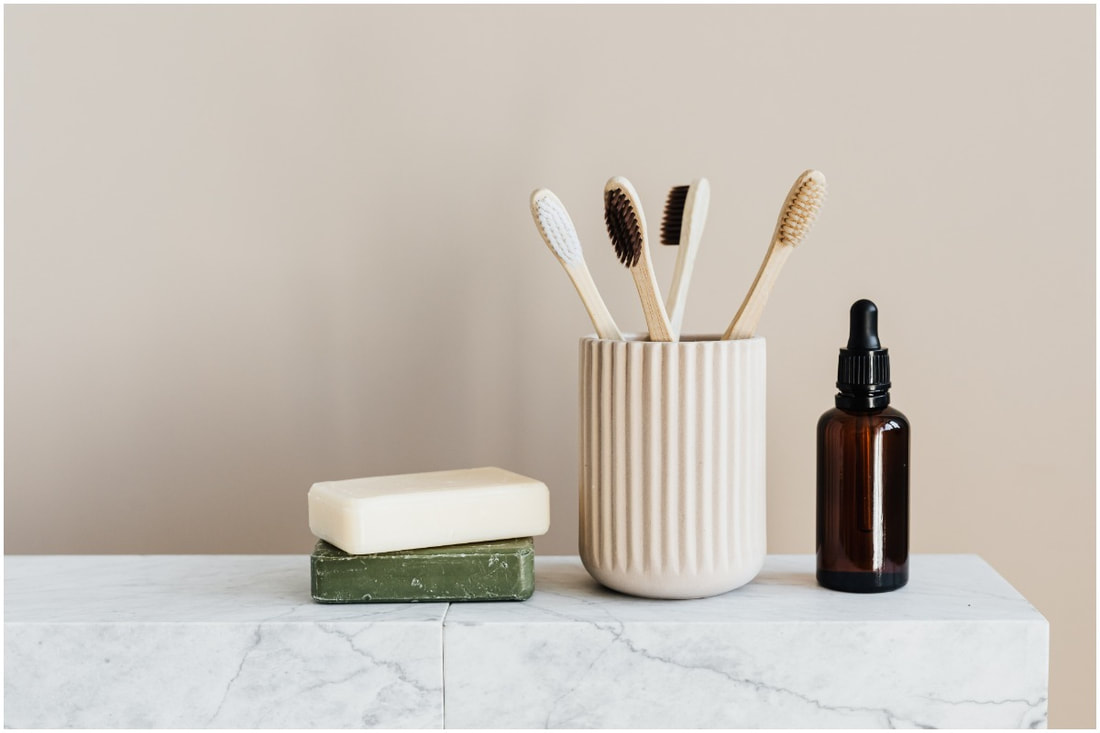Of course I said yes!
And I am excited to share that post with you here, where I, along with some other eco-friendly bloggers tell our tips for helping you achieve a zero-waste home.
Find the original post on Redfin.
To help you start making little eco-friendly changes in your home, we reached out to sustainability enthusiasts to share their best tips on achieving a zero waste home. Whether you’re renting a condo in Phoenix, AZ, or a homeowner in Baltimore, MD, you’re sure to find easy ways to live greener.
Do you want to change the world, go zero waste, and dramatically reduce your home’s carbon footprint? Start with the small, easy things, and every month add in something else until you and your house are a zero waste legend. Take baby steps like switching to reusable coffee filters or using glass food containers instead of plastic bags. If you jump in and go from 0 to making your own organic beeswax wraps, it’s not going to last. – My Peace Love Life
2. Keep your neighbors in mind
You might think the perfect place for your compost pile is at the north end of your garden, but if that also happens to be 20 feet from your neighbor’s back deck, you should really rethink that placement. Just like how you shouldn’t position your chicken coop outside of your neighbor’s bedroom window. Taking your neighbors into consideration isn’t only a nice thing to do, but it could also save you from getting complaints raised against you to the town or your HOA. – The Cape Coop
3. Be aware of the waste you create
On the road to zero waste, start by being aware of all the waste you create in your home and take action – things like composting your food scraps, recycling and eliminating unnecessary things in your life. For example, many single-use plastic household items have a sustainable alternative that won’t harm the earth – or your wallet. You may have swapped some already, but one you might have overlooked is single-use plastic trash bags used in your kitchen, bathrooms, or bedrooms that can easily be replaced with reusable bin liners. – TOMbag
4. Eliminate single-use plastic products
Eliminating toxic single-use petroleum plastics is essential to a healthy zero waste home. Using alternative materials such as glass, steel, hemp, and aluminum that are infinitely recyclable or home compostable is a great way to reduce waste while using reusable and refillable products. These products include hemp, paper, bioplastics, wood, concrete, insulation, fabrics, and many more amazing products that can be composted at home, creating a truly circular economy. – Dama Distributing
5. Start with your bathroom
Creating a zero waste household takes a holistic approach. Often, zero waste is pigeonholed into food and food packaging. However, your everyday self-care products are a major source of unnecessary plastic use – especially when it comes to dental products, shampoos, and more. Some innovative brands are taking a zero waste approach to self-care essentials and products like toothbrushes can be swapped out for bamboo. Brands are even creating zero waste shampoo bars now that contain no plastic packaging. – Roaming Vegans
There are some simple, sustainable product-swaps homeowners should consider when looking for ways to make an impact on the future of our planet. Oral-care products can be a great start because it’s a daily necessity for one’s health but can create a lot of pollution in our oceans and landfills. Switching to a zero waste, biodegradable silk floss and a bamboo toothbrush is an easy switch every family can make. – WooBamboo
It’s estimated that 40 million mattresses are thrown away each year in the USA, with most going directly to a landfill. That’s why it’s important to invest in a certified organic mattress made with sustainable materials like organic latex designed to break down and oxidize over many years unlike mattresses made with polyurethane foams that continuously emit toxic gas and chemicals into our environment. Another way to reduce waste is to invest in a mattress that’s made to last and is backed by a solid 20-year warranty, ensuring you’ll be able to keep your mattress longer and reduce your overall waste. – Tim Masters, Founder, and Owner of My Green Mattress
7. Refuse and reuse
When adopting a zero waste home plan, always refuse and reuse. First, refuse what you don’t need. The easiest way to do that is by saying no to plastic bags, forks, and spoons from takeout orders. Then, only buy what you can reuse. Opt for glass straws, glass containers, reusable bags, and eco-friendly items. Nowadays, there are eco-friendly alternatives to your everyday items. Always refuse single-use plastics and reuse and repurpose as much as possible. – augustnoa
8. DIY common household items
Create a simple DIY deodorant with three ingredients – shea butter, arrowroot powder, and essential oil. It’s a simple, effective, and natural zero waste solution for fighting armpit odor. You can also try to create a DIY re-mineralizing tooth powder – it’s cheap, easy, plastic-free, and will naturally whiten your teeth and freshen your breath. You can make it with a few easy-to-find ingredients – bentonite clay, baking soda, xylitol, and essential oils. Finally, avoid buying single servings. If you can’t find something plastic-free, get the biggest size available, even if it’s plastic. This will reduce the overall waste. – Almost Zero Waste
9. Swap disposable items with reusable alternatives
Pick five products in your home that are typically bought in a single-use plastic container, such as laundry detergent, dishwashing soap, shampoo and conditioner, face and body razor, or paper towels. Then, replace these items with products that aren’t packaged in or are composed of plastic. Instead of liquid laundry detergent, consider laundry detergent sheets packaged in a paper box, and swap out your liquid dishwashing soap, shampoo, and conditioner with a solid bar product. Over time, replacing disposable items with reusable ones will bring you closer to achieving a zero waste home. – Plastic Free QAC
10. Get to know your local waste streams
Identify eco-waste streams in your city/municipality that’ll recycle or reuse your unwanted items instead of sending them to a landfill. Look for a hard-to-recycle center for hardware items like electronics, paint, and tires, seek out a community garden for your kitchen scraps, and determine shops or organizations that’ll take your unwanted clothing. – Fort Negrita
11. Start composting
Before chucking yard clippings or coffee grounds, think about composting to build the health of your soil and minimize your contribution to the landfill. Build the quality of your garden’s soil by recycling scraps from the kitchen and yard with composting. Anyone can start a compost bin – whether it’s under their kitchen sink (vermicomposting) or in a spot in the backyard (traditional or rotating cylinders). – Florida Gardenista
One great step to take toward sustainable living is starting your composting journey. There are a few easy items you can start saving to turn into valuable compost: eggshells, vegetable cuttings, bread, yard trimmings, coffee grounds, and tea leaves. Bonus, add a touch of organic dry fertilizer like Geoflora Nutrients to your compost pile for a boost of beneficial nutrients and bacteria that your garden will love. – Geoflora
Reducing food waste isn’t just about meal planning and avoiding plastic packaging: it’s also about shopping local to cut down on spoilage and transportation emissions and repurposing and composting scraps. Along the same line, a no-waste yard isn’t just about cutting down how much water you use: it’s about rainwater collection, improving drought tolerance by planting native species and using electric maintenance tools (gas will never get cleaner, but the grid will). Sustainable living is a journey – take it one step at a time and remember to celebrate your progress. – Green Beverly
13. Buy only what you need
Take that conscious step to achieve zero waste by buying and consuming only what you need, thereby minimizing food waste. Remember, you can reinvent leftover food into new and exciting dishes too. Finally, make that conscious effort to live a trash-free environment by ditching single-use plastic bottles and switching to using glass and stainless-steel containers that can be cleaned and reused over and over again. If you can’t avoid purchasing commodities in plastic, let your creativity work by upcycling them into useful and decorative projects. – SJ Wave
14. Keep good habits – even away from home
Don’t abandon all those good habits when you’re out and about or heading off on vacation. Convenience foods consumed on-the-go generate huge volumes of waste, so to pack your reusable drinks bottle, shopping bag, cutlery, and perhaps even a washable napkin as standard so you won’t be adding to it. If you have little ones, keep a damp napkin or facecloth in a resealable plastic box or bag to keep sticky hands and faces fresh. – Travel Without Plastic
15. Switch to an all-purpose cleaner
The transition to zero waste starts with the products we use to maintain our homes. Instead of purchasing multiple ready-to-use cleaning materials for the bathroom, kitchen, laundry, etc., consider all-purpose cleaners like AFM All-Purpose Cleaner concentrate to do it all. These liquids can be mixed with water to 20:1 for very light cleaning, or used straight as your laundry detergent. No chemical residuals, no fake fragrances. – Andrew Pace, Founder of The Green Design Center
16. Transition towards sustainable living practices
Connect with a local solar or renewable energy company. There are many contractors who’ll install a system at very little cost and then you pay your monthly electric bill to them until you pay off the system. Secondly, think about how you can connect locally to your food source. Find a local CSA and become a member or grow more of your own food. There are many practices that can offset our impacts, but overall it’s really important that we know our actions make a difference and we will take a level of responsibility for getting our needs met in a sustainable way. – Earth Mountain Education Farm"
Peace Love and Zero Waste

















